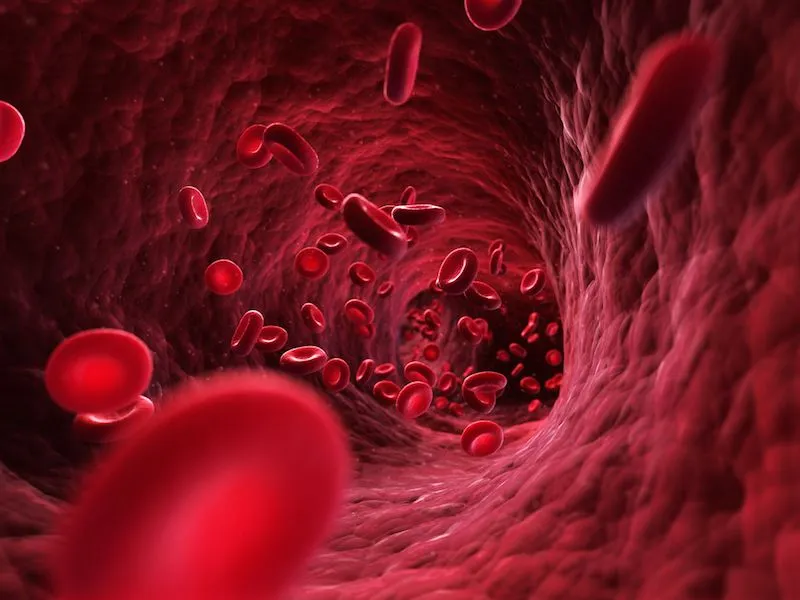How many Liters of Blood are in the Human Body?
The average adult has about 10.5 pints of blood in their body, but this amount can vary depending on factors such as a person’s age and size. It makes up about 7-8% of the body weight of an adult. A person can lose about one liter without harming the body. The blood responds to:
- About 7-8% of an adult’s body weight
- About 8-9% of the child’s weight
- About 9-10% of the baby’s weight
Learn more about average blood volume in adults and children in this article. You will also learn what causes blood loss, how it affects the body, and what to do if it happens.
Introduction
Blood volume refers to the total amount of fluid circulating within the arteries, capillaries, veins, venules, and heart chambers at any time. Red blood cells (erythrocytes), white blood cells (leukocytes), platelets, and plasma are the substances that give blood its volume. About 60% of the total volume of blood is made up of plasma, and the remaining 40% is left up of erythrocytes, leukocytes, and platelets. A person’s internal blood volume varies based on their size and weight, but an adult human has approximately 5 liters of blood in their body on average. Compared to men, women typically have smaller blood volumes.
However, a woman’s blood volume increases by about 50% during pregnancy. Blood volume is tightly regulated and related to several organ systems. In addition, it is closely related to sodium content and hydration status. Maintaining blood volume is critical for normal function, as it is essential for continuous perfusion of body tissues. Systemic dysfunction can increase or decrease blood volume. Changes in blood volume can lead to various clinical scenarios such as hypovolemic shock or edema.
There are two equations to estimate blood volume based on a patient’s gender, height (H) and weight (W). The Nadler equation is based on Dr. Allen’s 1962 work, while the Lemmens-Bernstein-Brodsky equation is more accurate for larger ranges of body weight and BMI in patients without critical illnesses.
The Nadler equation:
- Men: Blood volume = (0.3669 × H^3) + (0.03219 × L) + 0.6041
- Women: Blood volume = (0.3561 × H^3) + (0.03308 × l) +0.1833
The Lemmens–Bernstein–Brodsky equation:
- Blood volume = 70/[sqrt(body mass index/22)]
Amount of blood
Blood volume is the amount of blood (blood cells and plasma) in each person’s circulatory system. The amount of blood in the human body can vary according to age and size. An average adult has 10.5 pints (5 liters) of blood, although that amount depends on various factors. A woman’s blood can increase by up to 50% during pregnancy. An average blood test is:
- About 9 pints (4.3 liters) of blood in an average-sized woman (5 feet 5 inches tall and 165 pounds)
- About 12.2 pints (5.7 L) for an average man (6 feet tall and 200 pounds)
- For an infant, about 1.2 ounces (fl oz) for every kilogram of body weight (75 to 80 milliliters (ml) of blood per kilogram).
- In a child, about 1 to 1.2 ounces for each kilogram of body weight (70 to 75 ml of blood/kg)
People
The blood volume of a typical adult is about 5 liters, and women and men have about the same percentage of blood by weight (about 7-8%). The kidneys regulate blood volume. Blood volume (BV) can be calculated from hematocrit (HC; the fraction of blood that is red blood cells) and plasma volume (PV), and hematocrit is regulated by the blood oxygen regulator. Measurement of blood volume can be used in people with congestive heart failure, chronic hypertension, kidney failure, and intensive care.
The use of relative blood volume changes during dialysis is questionable. Whole blood volume can be measured manually using the Dual Isotope or Dual Tracer Technique, a classic technique available since the 1950s. This method requires double labeling of blood; i.e. 2 injections and 2 standards (51Cr-RBC for labeling red blood cells and I-HAS for labeling plasma volume) and withdrawal and re-infusion of patients’ blood to obtain blood volume analysis results. This method can take up to 6 hours to produce accurate results. Adult men have a blood volume of 70 ml/kg, adult women 65 ml/kg, and children (1 year and older) 70-75 ml/kg.
Semi-automatic system
Blood volume can also be measured semi-automatically. Daxor Corporation’s BVA-100 is an FDA-approved diagnostic device used in leading medical centers in the United States, consisting of an automated well counter interfaced with a computer. It can report with 98% accuracy in 60 minutes. total blood volume (TBV), plasma volume (PV), and red blood cell volume (RCV) using the indicator dilution principle, microhematocrit centrifugation, and the ideal height and weight method. The indicator is the injection of I-131 albumin.
The same amount of tracer is injected into the known and unknown volumes. The clinically unknown volume is the volume of the patient and blood in which the tracer was injected into the patient and the circulation and marked in the blood plasma. After injecting the tracer, the technician takes five blood samples and is subjected to microhematocrit centrifugation to extrapolate the actual blood volume at time 0. The concentration of I-131 in the blood is determined based on the radioactivity of the blood in a known volume relative to a standard with a known dilution of I-131. The unknown volume is inversely proportional to the concentration of the indicator in the known volume. the larger the unknown volume, the lower the tracer concentration, so the unknown volume can be calculated.
Microhematocrit data combined with I-131 tracer data provides a normalized hematocrit number that is more accurate than hematocrit or peripheral hematocrit measurements. Measurements are taken 5 times at 6-minute intervals so that the BVA-100 can calculate the albumin transit time to understand fluid flow across capillary membranes. Blood volumes have also been measured in humans using the non-radioactive carbon monoxide (CO) breathing technique for over 100 years. With this technique, a small amount of pure CO gas is inhaled and exhaled again within a few minutes. During respiration, CO binds to hemoglobin in red blood cells.
Based on the increase in blood CO after the respiratory period, the blood volume can be determined by the dilution principle (ie in the same way as in the case of radioactive labeling methods). Although large amounts of CO gas are toxic to humans, the volume used to produce blood volume is equivalent to the volume inhaled while smoking a single cigarette. While researchers typically use special breathing circuits, Detalo Health’s Detalo Performance has fully automated the procedure and brought the measurement to a wider user base.
Why and how should your doctor measure your blood volume?
Your doctor usually won’t measure your blood count directly because he or she can estimate it based on other factors and tests. For example, a blood test called hemoglobin and hematocrit can measure how much blood is in your body compared to the amount of fluid. The doctor can then consider your weight and likely hydration. All of these factors can indirectly measure your blood volume. When you experience major trauma that causes blood loss, doctors usually use your weight as a baseline to estimate how much blood you have. They will then assess factors such as your heart rate, blood pressure, and respiratory rate to estimate how much blood may have been lost. They also try to control further blood loss so they can quickly replace it with a blood transfusion.
Blood volume test
The blood volume test can measure the amount of blood in the human body. Your doctor may use this test to evaluate a variety of conditions, such as:
- Heart failure
- Renal failure
- Shock
There are several testing methods, but a blood volume test usually involves injecting a small amount of a tracer into the body. A healthcare professional uses imaging technology to monitor blood flow in the body.
How many liters of blood are in the human body, Is it different for men and women?
The amount of blood in your body usually corresponds to 7% of your body weight. But this is an estimate, as it may depend on your gender, where you live, and other factors.
Estimates of blood volume are as follows:
- Infants: Full-term infants have about 75 milliliters (ml) of blood per kilogram of body weight. If a baby weighs about 8 pounds, his body has about 270 ml of blood or 0.07 gallons.
- Children: The average 80-pound child has about 2,650 mL of blood, or 0.7 gallons.
- Adults: A 150–180-pound adult needs between 1.2 and 1.5 gallons of blood in their body on average. This is about 4500-5700 ml.
- Pregnant women: To support their growing babies, pregnant women generally have 30 to 50 percent more blood volume than non-pregnant women. This is about 0.3-0.4 liters of blood.
Sometimes the amount of blood in the human body can vary depending on where you live. For example, people living at high altitudes have more blood because there is not as much oxygen. Plasma, blood cells, and platelets make up blood, a liquid connective tissue. It carries oxygen and nutrients to many cells and tissues throughout our body. The amount of blood in a person’s body is determined by size and age. It does not harm the body if a certain amount of blood is lost. The average adult’s body contains about 10.5 pints (5 liters) of blood, although this depends on several factors.
A woman’s blood volume can increase by 50% during pregnancy. There are different testing methods. However, the blood level test often requires the injection of a tracer chemical into the body. It checks the blood with the healthcare worker’s imaging equipment. The volume of blood in the body of an adult varies from 1.2 to 1.5 gallons (4,500 to 5,700 ml). Pregnant women also have 0.3-0.4 liters of extra blood because they have a growing baby.
This increased blood flow helps deliver the baby. The amount of blood in men or normal women is significantly different. The average woman has 4.3 liters of blood in her body, while the average man has 5.7 liters of blood. Their age and size determine the amount of blood in a person’s body. It does not harm the body if a certain amount of blood is lost.
How much blood can you lose or donate?
According to the American Red Cross, the usual amount of blood to donate is 1 pint. This is about 10% of the blood in the body and is a safe amount of blood to lose.
After donating blood, a person may pass out, so donation centers ask donors to rest for 10-15 minutes and drink refreshments before leaving. If a person has an illness or an accident, they may lose more blood. This is potentially fatal and causes shock. If you lose too much blood, your brain doesn’t get enough oxygen to sustain life. People who experience serious injuries and trauma, such as in a car accident, can lose blood very quickly. Loss of excessive bleeding is called hemorrhagic shock. Doctors classify hemorrhagic shock into four categories based on blood loss. In class IV, blood loss can result in death. Here are the categories of blood disorders
Classes class I class II class III class IV
- Blood loss (ml) up to 750 750 – 1000 1500 – 2000 more than 2000
- Blood loss (%) up to 15 15 – 30 30 – 40 Over 40
- Heart rate (per minute) less than 100 100 – 120 120 – 140 Greater than 140
- Blood pressure Elevated decreased decreased decreased
- Respiratory rate/min 14 – 20 20 – 30 30 – 40 over 35
- Urine output (ml/hour) more than 30 20 – 30 5 – 15 negligible
- Mental state slightly anxious Anxious anxious confused confused lethargic
Your blood pressure and heart rate will remain normal if you lose up to 30 percent of your blood, or up to 1500 ml of blood (0.4 gallons). After losing this amount of blood, you will experience:
- You start having a fast heart rate of over 120 beats per minute.
- Your blood pressure drops.
- Respiratory rate increases. If you lose more than 40 percent of your blood, you die. An average adult encompasses roughly 2,000 milliliters, or 0.53 gallons, of blood. To avoid this, coming to the hospital and starting blood transfusions is important.
Shock and blood loss
Heavy bleeding can be dangerous. In medical terms, shock means that the body’s tissues are not getting enough oxygen. The brain and other organs can be harmed with low oxygen levels. When someone loses blood, the body begins to direct blood to vital organs and away from the skin, fingers, and toes. The person may turn pale or feel numbness in the limbs. If a person loses about 15% of their blood volume, they may go into shock, although their blood pressure and other signs will likely be normal at this point.
After a 20-40% drop, blood pressure starts to drop and he feels anxious. As they lose more blood, they begin to feel confused. Their heart rate can increase to around 120 beats per minute (bpm) as the body tries to maintain blood flow to vital organs. If the blood loss is 40% or more, the person is in severe shock. Their heart rate increases above 120 beats per minute. They feel lethargic and may lose consciousness.
Causes of bleeding and shock
Bleeding can be external or internal, but both types can cause shock. External bleeding: Head injuries or a deep wound or cut in or near a vein, such as on the wrist or neck, can cause severe blood loss. Internal Bleeding: An internal injury, such as a blow to the stomach, can cause sudden and significant blood loss, but it may not be visible externally.
Medical conditions such as a perforated ulcer, lung cancer, or ruptured ovarian cysts can also cause internal bleeding. Depending on the location of the internal bleeding, bruising may occur. Blood may leak through the mouth, nose, or other openings.
Get help
A person with heavy bleeding needs medical attention. Due to external bleeding, a person must:
- Sit or lie down
- If possible, raise the injured part higher
- Apply pressure to the wound or have someone else do it to stop the bleeding
Someone should call 911 if:
- Bleeding is heavy
- Bleeding does not stop or slow when pressure is applied
- Severe bruises on the body or head
- There is a change of consciousness or breathing difficulties
Blood transfusions
A blood transfusion is a medical procedure in which blood is given to someone who needs it. Possible reasons include:
- Lose a lot of blood
- You have a disease that affects the blood, such as cancer or anemia
A blood transfusion can be a life-saving procedure. People may also receive other blood components, such as plasma and platelets, for various therapeutic purposes.
How much blood do we produce per day?
A million red blood cells are produced in the body every second or so. In the bone marrow, stem cells give birth to red blood cells. One kind of cell that can create other cells is the stem cell. This process takes place continuously throughout a person’s life. Blood consists of different parts:
- Red blood cells carry oxygen and carbon dioxide.
- White blood cells help protect the body against disease and infection.
- Platelets help stop bleeding.
- Plasma transports blood cells, platelets, and other components and supports the immune system.
The American Red Cross states that it is 55% blood and 92% water. The Red Cross also reports that it takes the body about 24 hours to replace lost plasma, and 4-6 weeks to replace red blood cells. RBCs get their color from hemoglobin, which has iron. After blood loss or donation, it can take several months for iron levels to return to normal. The Office of Dietary Supplements notes that frequent donors may have low levels of iron in their blood. People who have experienced blood loss through donation or other causes may benefit from:
- Drink plenty of fluids, especially water
- Eat iron-rich foods, like beef liver and fortified foods.
How the body maintains blood levels
The cardiovascular system, or cardiovascular system, is responsible for the movement of blood in the body. In this system, the heart pumps blood into blood vessels that carry blood to the body’s organs. There, the blood delivers oxygen and other nutrients. Other important systems and organs include:
- Kidneys, which regulate the fluid balance of the body
- Bones, because the bone marrow produces blood cells
- The nervous system, which enables other systems to perform their tasks
A problem with these systems can affect circulation and blood volume, oxygen delivery, and a person’s ability to survive.
Take with you
About 7-8% of an adult’s body weight consists of blood. The body can easily replace a small amount of blood loss, which allows blood to be donated. If a person loses about 15% or more of their blood, there is a risk of shock. Anyone with signs of significant internal or external bleeding should seek immediate medical attention.
FAQs
What is the range of blood volume?
Several variables can affect blood volume, including:
Age, Sex, Body size, Hydration, Altitude
What occurs in the event of excessive blood loss?
Shock, a potentially fatal condition that arises when the body fails to pump enough blood to essential organs, can be brought on by severe blood loss. Accidents, wounds, or specific medical conditions may cause this.
Is it still possible to donate blood if your volume is low?
Blood donation is usually not permitted for those with low blood volume because it may worsen their condition. To make sure giving blood is safe for you, it’s crucial to speak with a doctor beforehand.
References
- Physiology, Blood Volume. (2023, January 1). PubMed. https://pubmed.ncbi.nlm.nih.gov/30252333/
- Blood volume. (2023, August 18). Wikipedia. https://en.wikipedia.org/wiki/Blood_volume
- How many liters of blood are in the human body is it different for males and females? (2022, May 30). Unacademy. https://unacademy.com/content/question-answer/biology/how-many-litres-of-blood-are-in-the-human-body/
- Sissons, C. (2023, December 6). How much blood does a human being contain?https://www.medicalnewstoday.com/articles/321122#how-the-body-maintains-blood-levels
- Crna, R. N. M. (2017, July 18). The amount of blood in your body and the amount that is potentially lost. Healthline. https://www.healthline.com/health/how-much-blood-in-human-body







